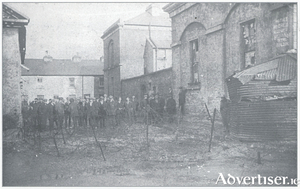Search Results for 'Geraldine Plunkett Dillon'
5 results found.
The Town Hall Internment Camp

The last months of 1920, were the most vicious and bloody in the War of Independence in Galway. There were a lot of killings, burnings, shootings and beatings.
A prison drama in the Town hall

November 1920 was the most vicious month in the War of Independence. Murder and mayhem were commonplace. The authorities reacted with vigorous severity. There were shootings and public beatings, buildings and homes burnt, and printing works wrecked. There was a sweeping roundup of the usual suspects, numbering in their thousands. The old gaol in Galway, and gaols throughout Ireland, were full to bursting point.
The professor in his wife’s overcoat
Tom Dillon, originally from Co Sligo, married Geraldine Plunkett, on Easter Sunday 1916. The Plunkett family were practically all committed to the Rising, and the subsequent War of Independence. Tom qualified from UCD as a chemist, worked with the Volunteers, and supplied them with a steady stream of hand grenades and bombs. In May 17 1918 he was arrested and interned with other Irish Rebels, in Gloucester prison, England.
Families and weddings Easter 1916
Joseph Plunkett and Grace Gifford were to have a joint wedding with his sister Geraldine Plunkett and her fiancé Tom Dillon, at the Rathmines church, Easter Sunday, April 24 1916. The confusion about the on/off Rising, the rumours about the possibility of Roger Casement being taken prisoner in Kerry, kept the couples guessing as to what would happen. But Joseph, one of the principle organisers of the Rising, probably knew more that what he said to his sister, that Grace ‘did not know the smallest thing about the political situation, and had no idea whatever of such things’.*
‘If we do nothing else we shall rid Ireland of three bad poets’
Poetry more than any other art form is intimately connected with the events of Easter 1916. Three of the executed signatories of the Proclamation, Padraic Pearse, Thomas MacDonagh (Tomás Mac Donnchadha) and Joseph Mary Plunkett were recognised poets of their day, who had used their poems to espouse the cause of revolutionary nationalism.

